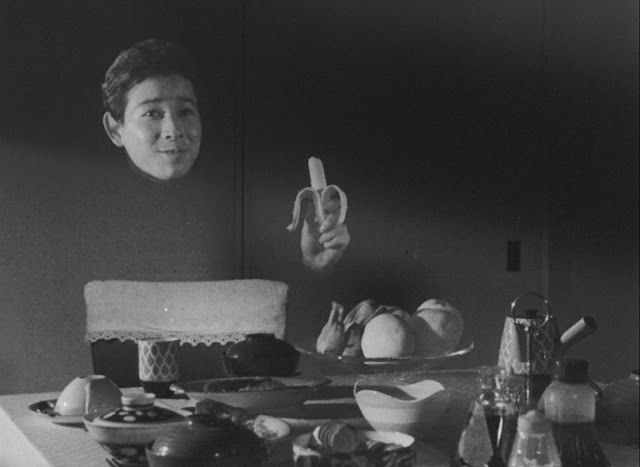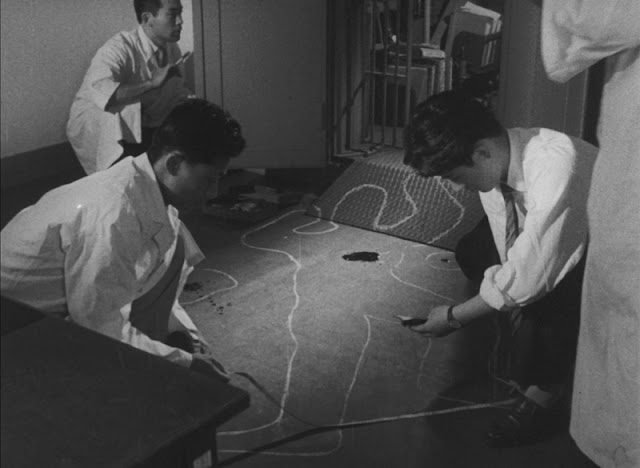(1957) Directed by Mitsuo Murayama; Written by Hajime Takaiwa; Starring: Ryûji Shinagawa, Yoshirô Kitahara, Junko Kanô, Yoshihiro Hamaguchi, Ikuko Môri, Ichirô Izawa and Shizuo Chûjô; Available on Blu-ray
Rating: ***
“Light has a fixed wavelength. The human eye is the same. The
human eye can only perceive light inside that wavelength. Conversely, if an
object doesn’t overlap with that spectrum, visible to the human eye, the object
cannot be seen. I think ‘imperceptible’ would be a more accurate description.” –
Dr. Tsukioka (Ryûji Shinagawa)
Daiei Studio’s first foray into H.G. Wells’ territory,* The Invisible Man Appears (1949), is essentially a caper film with a sci-fi twist. Police track a kidnapped scientist and his stolen formula, which enables an invisible jewel thief to act with impunity. Although not a direct sequel, Daiei’s 1957 follow-up, The Invisible Man vs. the Human Fly (Okay, really two invisible men and a woman, versus two human flies, but who’s counting?), ups the ante with a more outlandish premise that pits the transparent against the tiny. Both films were unavailable outside of Japan for years, but thanks to Arrow’s Blu-ray set,** we can finally enjoy them, more-or-less, as the filmmakers intended.
* Fun Fact #1: In-between Daiei’s flirtation with the invisible man, rival studio Toho threw its hat in the ring, with The Invisible Avenger (1954).
** Fun Fact #2: The only surviving prints were 16 mm that
were slightly worse for wear, but considering the less-than-pristine source materials,
the presentation looks pretty decent.
In the pre-credits sequence (set on an airliner), an industrialist
is murdered by an invisible assailant. All the passengers are suspects, but
none seem to have committed the crime. After a series of several inexplicable
murders, the police are understandably baffled, with few leads, except for a
couple of seemingly unrelated clues: the male victims served together during WW
II, and reportedly each murder is preceded by a buzzing sound, like a fly. While
the police initially think the assailant is invisible, signs point to something
else – something much smaller. Naturally, it takes an invisible person to take
down the miniaturized menace.
Police captain Hayama (Yoshihiro Hamaguchi) is provided a tour of his friend Dr. Tsukioka’s (Ryûji Shinagawa) secret laboratory, where he conducts experiments with a ray that generates wavelengths outside the visible spectrum. Anything that’s subjected to the ray (as opposed to a drug in the first film) renders the subject imperceptible to the human eye. Although human experimentation is forbidden, it doesn’t take long before an eager lab assistant uses the ray on himself, to become an invisible man (because calling him “The Imperceptible Man” doesn’t quite have the same panache).
The antagonist is businessman Kusunoki (Ichirô Izawa). After serving a prison term following the war, he plans to settle the score against his fellow colleagues, using a top-secret compound, which had been developed in a lab to shrink soldiers. The drug temporarily miniaturizes the user, enabling them to enter locations undetected. The term “human fly” is a misnomer, since the drug shrinks the subject, but doesn’t transform them into an insect (despite misleading shots of a housefly). Instead, the user becomes so small, they float around, riding the air currents (how this would work is anyone’s guess). Through this substance, Kusunoki’s psychopathic lackey, Yamada (Shizuo Chûjô), carries out his dirty work, as an unstoppable assassin. But each subsequent use of the drug leaves him wanting more and more. Is it the substance or the process of getting small that’s addictive? I don’t know, ask Steve Martin.
The Invisible Man vs. the Human Fly benefits from moody, noir-tinged cinematography by Hiroshi Murai, full of ample shadows and low-angle shots, giving the viewer a constant sense of mystery and unease. The “human fly” effects are not quite as convincing, as he appears semi-transparent in some shots, and his scale varies constantly. On the other hand, the invisibility effects are serviceable enough, and it’s refreshing to see (pun unintended) that the invisible man isn’t the antagonist here. The final scene of the movie seems to suggest the further crime-fighting adventures with an invisible man/woman duo, but unfortunately for us, it wasn’t meant to be. It’s regrettable that Daiei’s first Invisible Man movie and its eventual (and decidedly more fun) semi-sequel didn’t spawn a franchise of films. Universal, however, did its own successful reboot of The Invisible Man a few years ago, so maybe we’re overdue for his Japanese counterpart.






Fascinating and fun review, vbarry! I haven't heard of either of these films, but they do sound fun, especially the semi-sequel. Of course, I love that the Blu-ray release came from low quality 16mm prints. It gives me hope for the Lost films out there in the world.
ReplyDeleteThanks, John! :) I know, right? Who knows what's lurking in someone's basement, right now? ... Another Milligan movie, perhaps?
DeleteThis is such a fun and unique movie! I got this some time ago from Sinister Cinema, which would have been mastered from a 16mm print. It looks from your screenshots like Arrow did a great job cleaning it up for Blu-ray.
ReplyDeleteIt's a shame we didn't get more Invisible Man (or people) adventures, but this one's a hoot. And yes, considering the print, the image didn't look half bad!
Delete